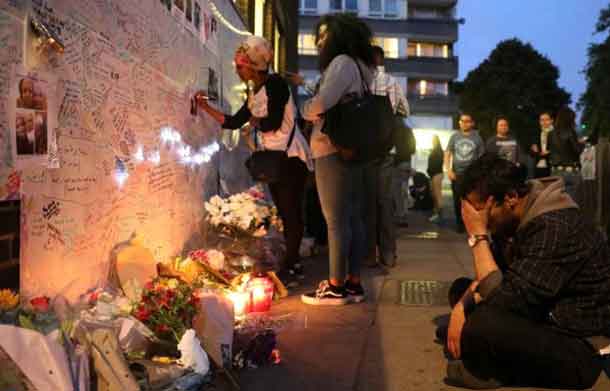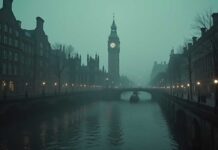
By Estelle Shirbon and Alistair Smout
Residents accuse local authority of neglect
LONDON (Reuters) – Within a short walk from the social housing block in west London where 17 people – and perhaps many more – died in a devastating fire are some of Britain’s wealthiest streets, lined with elegant, multi-million-pound townhouses.
The borough of Kensington and Chelsea is famous in Britain and beyond as the home of pop stars and other celebrities, jet-setters and bankers.
But it also has pockets of deprivation like the housing estate where the doomed 24-storey Grenfell Tower stands.
Dozens of residents are missing and authorities say the death toll could rise further after an inferno engulfed the building with terrifying speed as residents slept in the early hours of Wednesday. The lucky ones got out alive, but have lost everything.
The disaster has prompted an outpouring of generosity, with shocked Londoners donating so many clothes, shoes and bedsheets that volunteers were soon overwhelmed.
But on the streets around the charred carcass of the tower on Thursday there was palpable anger as people accused the local authority of neglecting the safety and wellbeing of the poor in favour of policies favouring the interests of the rich.
Alia Al-Ghabbani, a receptionist who lives on the estate, was among many angered by a recent refurbishment in which new cladding was added to the exterior of the building and which media reports have said might have played a part in the rapid spread of the fire.
“It’s really irritating why they prettied up the tower … It’s because that tower was such an eyesore for these people in very expensive houses just opposite,” she said.
The fire service has said it was too early to know what caused the blaze, and the local authority has said the refurbishment was designed to improve quality of life for residents of the block.
“A TALE OF TWO CITIES”
Community organiser Pilgrim Tucker, who had worked closely with residents of Grenfell Tower during the refurbishment period, saw the blaze as the tragic consequence of long-term neglect of an entire section of the community.
“People here in the social housing know they’ve been neglected,” she said, visibly distressed as she spoke. “If government was doing its job … this wouldn’t have happened.”
As Tucker and others reported that fire safety concerns raised by residents had fallen on deaf ears, the fallout from the disaster fed into the broader political picture.
In a shock election result last week, the ruling Conservatives, who emphasise fiscal discipline, low tax and pro-business credentials, lost ground to the opposition Labour Party, who favour more spending on public services.
To general astonishment, the Kensington parliamentary constituency, where the Grenfell Tower stands, was won by Labour for the first time in its history.
The new Labour MP Emma Dent Coad has been quick to try to make her mark, criticising the council, in a newspaper interview, for perceived safety failings and saying the tragedy was preventable.
Conservative Prime Minister Theresa May visited Grenfell Tower on Thursday, but was cricitised for speaking only to firefighters and not to residents.
In contrast, Labour leader Jeremy Corbyn was cheered after visiting a nearby church and meeting residents and volunteers helping out, with locals shouting “thank you for coming”.
“Something you can’t avoid is that Kensington is a tale of two cities,” Corbyn told reporters.
“The south part of Kensington is incredibly wealthy, it’s the wealthiest part of the whole country. The ward where this fire took place is, I think, the poorest ward in the whole country.”
“A CERTAIN SORT OF PEOPLE”
The area immediately around the Grenfell block, known as Notting Dale, is a socially mixed neighbourhood. The gritty 1970s social housing estate is surrounded by pretty streets lined with the well-tended, privately owned homes of affluent professionals — though not of millionaires. They live a few minutes away, in the prestigious Holland Park area.
In Notting Dale, despite local anger, the blaze has united different sides of the community all the same. Many wealthier residents have opened up their homes to tenants who fled the tower, or others who were evacuated because their flats were too close to the blaze.
Anabel Donald, a well-to-do grandmother, has lent her ground-floor apartment to six people from the estate who had nowhere else to go.
On the night of the fire, Donald rushed to the local church in her pyjamas and spent hours helping evacuees as best she could, making tea, providing toys to entertain the children and cleaning the toilets which were being used by dozens of people.
Though from the wealthier side of the street, Donald shared the outrage of other residents about the way Kensington and Chelsea has been run by the Conservative local council.
“The feeling is, among the less privileged, that they get nothing and that the more privileged get everything. I think it is absolutely true,” said Donald.
She accused the council of keeping taxes unnecessarily low, when it could easily raise more money to spend on social housing and other public services. She said she would happily pay more local tax herself.
“They’re just very proud of being such an economical borough and they do it because they think it will please a certain sort of people,” she said.
Amid the horror of the tower blaze, she said social divisions had seemed to matter less than usual.
“I have never felt more accepted in this area than I was when I was helping, because they didn’t care which side of the divide I came from. All they cared about was I was playing with their children, giving them nappies, giving them tea and coffee.”
(Additional reporting by Michael Holden, Kate Holton and Will James; Writing by Estelle Shirbon; Editing by Richard Balmforth)





